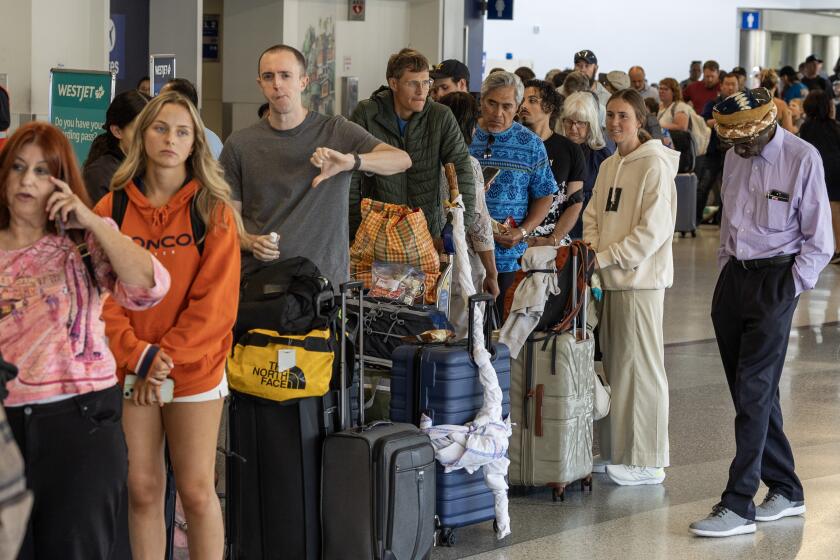City Statues : Anatomy of a Decline in Old Heroes
Rudolph Valentino lost his nose three times. Florence Nightingale had both arms lopped off. Revolutionary War hero Haym Salomon had an eye gouged out.
The statues of Los Angeles have taken their lumps over the years.
So much so, in fact, that by the 1960s, figurative sculptures had all but stopped sprouting up in the city, though the late singer John Lennon had a brief run near City Hall in the early 1980s (and had two sets of bronze eyeglasses stolen in the process).
“The vandalism was one factor (in the decline),” said John Ward, a Recreation and Parks official. “Also, not many artists do that kind of work any more. These days you beat up an old automobile, turn it upside down and call it a statue.”
Latino Heroes Although the city’s sculptures have been vanishing and popping up in new places for some time, the population of figurative statues is on the increase in one part of the city. And, as with the general population, it has an ethnic aspect.
El Parque de Mexico in East Los Angeles, a project of City Councilman Arthur Snyder, has acquired nine statues and busts of Mexican historical figures, including revolutionary leaders Emiliano Zapata and Francisco (Pancho) Villa, in the last few years--all donated by Mexican government and business sources.
Pedestals are reserved for 17 more busts for the small park at the corner of Valley and Mission boulevards, and there seems to be no shortage of nominees or sponsors.
“When the park was proposed, some of the other councilmen said that it would be destroyed by vandals,” recalled Yolanda Guerra, a Snyder aide. “But the amazing thing is we’ve had no vandalism, no graffiti. People here respect it as a tribute to the heritage of this city and the Mexican community.”
If anything, the public’s response has occasionally been overenthusiastic.
“We’ve had a few problems over whom to accept,” Guerra said. “The park is so small that we have to be careful to limit the number or it would look like a cemetery. One person phoned us and said he was planning to have a statue made of his grandfather for the park because he had fought next to Pancho Villa.”
Alas, most of the older statues of Los Angeles no longer inspire such enthusiasm.
When a bronze of Ludwig van Beethoven was being created in 1933, individual members of the Los Angeles Philharmonic Orchestra played Beethoven compositions in the Glendale studio of sculptor Arnold Foerster to provide inspiration. (The members also provided another type of inspiration--they raised all the funds for the work.)
But parks people say that Beethoven devotees no longer show up in Pershing Square on the anniversaries of the composer’s birth and death to swab down his statue, as they once did. Fortunately, the bronzed German composer, with head bowed, hands behind his back, seems too engrossed in thought to notice.
Not since the 1950s have the Native Sons of the Old West--Superior Court judges among them--gathered on the birthday of former U.S. Sen. Stephen White (1853-1901) to bathe his statue, now located on the corner of 1st and Hill streets.
And the last time a crowd gathered at the bust and fountain that honor the late U.S. Sen. Frank Flint (1862-1929) on the south side of City Hall, it was for a sad spectacle.
“I was coming to work one morning and there was a group of people in front of the fountain,” says Ward, assistant general manager of the park department’s San Fernando Valley region. “A wino was stretched out on the bottom, dead. He’d drowned. Poor fellow, his sack and wine bottle were floating nearby.”
The city has since turned off the water in the fountain.
Many of the older sculptures depict figures that are somewhat obscure today, including White, who helped develop Los Angeles Harbor (but, since his statue was moved, is gesturing east, more in the direction of the Great Salt Lake), Flint, for whom Flintridge was named, and attorney Joseph Scott (1867-1958), a civic leader who stands outside the County Courthouse on Olive Street.
In fact, one reason for the swing away from figurative art in this country, as the late sculptor David Edstrom pointed out, is the fear that with the passage of time a work will be dismissed as “just another man in trousers.”
Parks officials and workers are big fans of abstract art.
Less Controversial “Modern art can be very strong,” said Dick Genevan, a park maintenance supervisor. “For instance, a steel sculpture is very hard to vandalize. And modern art is generally less controversial. If there’s an anti-American rally at MacArthur Park, then (Gen. Douglas) MacArthur’s statue may be attacked because he’s an American hero.”
Some modern sculpture, of course, elicits groans, such as the Triforium in the Los Angeles Mall, a six-story tower that one critic dismissed as a “$900,000 jukebox.”
Like the public, the parks department, because of budget restrictions, pays less attention to the statues than it once did. No longer do the honored receive scrub jobs, except when one has been splattered with something strong. Un-retreating MacArthur is occasionally pelted with paint.
When do they get washed off? “When it rains,” said one park official, who is confident that the sculptures aren’t crumbling.
Overall, the city’s statue family is in relatively good health these days. Nightingale of Lincoln Park, which is 58 years old, Valentino, 54, of DeLongpre Park and Salomon, 40, of West Wilshire Recreation Center, all have had their vital parts reattached by city masonry workers. And Ginevan said the department now has a sculptor on the payroll in case any more transplants are needed.
One figure who has not been forgotten is Salomon, a Polish Jew who is said to have given his personal fortune to the Colonies during the Revolutionary War.
The target of numerous acts of vandalism over the years, his statue has been moved twice at the insistence (and expense) of Jewish organizations, from Hollenbeck to MacArthur parks and, last year, to its present location in a predominantly Jewish area.
In order for a statue to rise in a public part of the city, it must win the approval of the Recreation and Parks Department (“It must be solid, for one thing,” Ginevan noted) and of the Cultural Affairs Department, and it must be privately financed.
For instance, the Nordic Civic League paid for the bust of Leif Erikson (this is the way it is spelled on the plaque) in Griffith Park along with a plaque that says the Norwegian explorer discovered America. Italian-American groups later retaliated with a statue of Christopher Columbus in the County Mall.
No one knows how just many statues are in the possession of the city because only recently has an attempt been made to index them. There may be about 100. The current master list is incomplete (missing, for instance, aviator Amelia Earhart’s monument in North Hollywood; poor Amelia, always missing). The statues date back at least to White’s (1907).
“In the old days someone would approach the city with a request and the city would say, ‘Certainly,’ and up it’d go,” Ward said. “I’m sure with many of them we don’t even know who the sculptors were.”
Valentino once disappeared for two decades.
“He was standing on a rounded globe with his toes attached to a metal rod and the kids kept spinning him around,” Ward said. “He was always falling off. Finally somebody picked him up and took him to our central service yard. Whoever put him there lost track of him and he was there about 20 years. Then about eight years ago, I got a call from someone who said there was a funny-looking statue, looked like a globe, what was it? We devised another away of putting him on so he couldn’t be twirled around and put him back.”
Washington Mystery But apparently missing is a statue of George Washington that stood in front of the old County Courthouse. A 1947 newspaper clipping says it was about to be moved elsewhere. Asked about the 1,500-pound granite work, park officials say they have never heard of it.
A more recent disappearing act involved the statue of Lennon, which stood in City Hall East on loan to the city while the sculptor, Brett Livingston-Strong, searched for a buyer. It went back to a New York exhibition in 1983 and hasn’t been seen since. (Livingston-Strong, who also has a statue of Lawrence Welk in San Diego, did not return a reporter’s calls regarding the whereabouts of the Lennon work.)
One of the unforeseen consequences of the founding of El Parque de Mexico was the ironic juxtaposition of two old adversaries: Villa and Gen. John J. (Black Jack) Pershing, who stands in the downtown park named for him.
When Villa attacked Columbus, N.M., in 1916, it was Pershing who led an unsuccessful U.S. military expedition in pursuit of the Mexican general.
Now Villa, as though executing a flanking movement, is slightly north of Pershing. Black Jack, unbeknownst, is staring the other way, toward Mexico.
More to Read
Sign up for Essential California
The most important California stories and recommendations in your inbox every morning.
You may occasionally receive promotional content from the Los Angeles Times.






